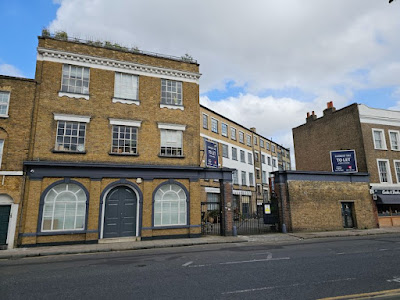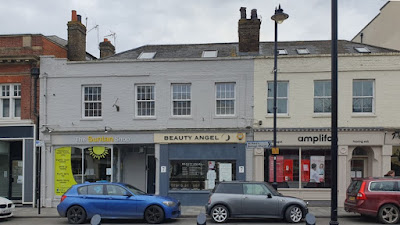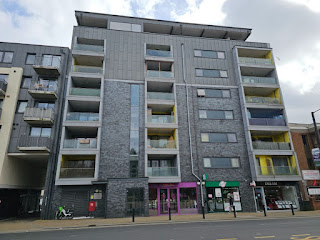Atari House, Railway Terrace, Slough, SL2
202 New North Road, London, M1 7BL
Atari's games and consoles were on sale in the UK before Atari established its UK branch. A company called Softcell was bringing games in from America and in 1983 they would metamorphose into the better known distributor Centresoft; future owners of the US Gold label. The bulk of hardware distribution was handled by a different company, Ingersoll Electronics. This timeline suggests Ingersoll Electronics began distributing Atari products in the UK around March 1979, taking over from a company called Cherry Leisure. Ingersoll produced a newsletter called ATARI OWNER'S CLUB BULLETIN which dates pretty much from the point Ingersoll took over distribution and remarkably those early 1979 issues survived to be archived online. The first two are single sided and then issues three and four are double sided. Issue five sees the bulletin becoming a four page newsletter and the cover shouts: "HURRAH! AT LAST -AND IN TIME FOR CHRISTMAS!" which nicely dates it to November or December 1979. The following issue, Ingersoll boasts about their television commercials some of which have been uploaded to YouTube.
 |
| April 2024 |
New North Road was built 1812-22. That's how new it is. There isn't actually a number 202, the street numbers jump from 200 to 208; which covers an area locked off behind gates. This is Canonbury Yard. It's contemporary with the rest of the buildings along New North Road and shows up on old ordnance survey maps as a place called Wilton Works. Ingersoll Electronics was, presumably, at one point based in the off the road section pictured above. Google turns up a lot of results for Ingersoll but very little substantial information. It was a subsidiary of Heron International, by the early 1980s Heron was one of the largest private companies in the UK.
7 High Street, Maidenhead, Berks, SL6
 |
| March 2023 |
5/7 Forlease Rd. Maidenhead, Berks SL6
Atari set themselves up in the UK on 14th May 1982 as Atari Games International (UK) Inc. A single full-page colour advert appears on the inside front cover of the May 1982 issue of YOUR COMPUTER. Captioned "ATARI BRINGS THE COMPUTER AGE HOME," it showed an excited family sitting round their colour television and beaming with delight at the musical scale displayed on screen. This is a UK version of an American advert which originally ran in 1981; according to a post on Reddit.
 |
| Left, UK 1982 and right USA 1981 |
It's fun to compare the two adverts. I'm fascinated by how carefully the UK version recreates the composition of American original. If you glanced at the two individually you might not even notice the differences. The UK advert invites people to write to RH Associates at 5/7/Forlease Road, Maidenhead. The probable site of which is now occupied by the Maidenhead branch of a popular supermarket. It's time for a commercial break.
 |
| March 2023 |
The strange thing about the Atari advert is, it was only used once in that issue of YOUR COMPUTER. I struggle to think of a reason why a company would commission an advert and only use it once. The point of an advertising campaign is that it's, you know, a campaign. Granted the UK computer magazine market was still small but in addition to YOUR COMPUTER there was also COMPUTER & VIDEOGAMES and PERSONAL COMPUTER WORLD. Or why not use it in the ATARI OWNER'S CLUB BULLETIN? Obviously I have questions and no answers.
"You'll have heard that Atari International (UK), inc. has come to an arrangement with Ingersoll Electronics whereby ATARI is now distributing its Atari VCS and Atari Home Computers in the UK and Eire." That was how the new UK company introduced itself in issue 20 (Spring 1982) of the ATARI OWNER'S CLUB BULLETIN. Most traces of the previous regime have been swept away and the contact addresses change from Ingersoll to Ray Hodges. The biggest change comes when issue 21 arrives.
 |
| Atari Owners Club Bulletin, left to right issues 19, 20, and 21 |
Windsor House, 185 Ealing Road, Alperton, Wembley, Middlesex
Actually the address on page six of issue 21 was an anonymous PO box number in Wembley but issue 22 (September 1982) revealed the full address. 185 Ealing Road was the home of another Warner Communications subsidiary; WEA Records. It's gone. You can see the unremarkable 1980s red-brick office building just before it was demolished on 2008 Streetview images. Atari were not based at 185 Ealing Road for long, but the address casts a long shadow because it appears on a trio of threatening adverts..jpg) |
| Left to right PERSONAL COMPUTER WORLD, November 1982 page 192 and December 1982 pages 70 and 178 |
The legal action caused a sensation. POPULAR COMPUTING WEEKLY (26 August 1982 page 4) correctly described it as having "far reaching implications." No kidding. Look through that July 1982 issue of YOUR COMPUTER; on page 6 J.K. Greye Software is selling Breakout, that's a copy of an Atari arcade game; on pages 8 and 9, dk'tronics is advertising Centipede (Atari, again), Space Invaders (Taito) and Asteroids (Atari); Bug-Byte's advert on page 22 features Another Vic in the Wall (that's Breakout again), Vic Asteroids, Invaders, Galaxians (Namco), Breakout (for the Acorn Atom computer), and Lunar Lander (Atari); on the opposite page Silversoft is offering Muncher!! ("At last! PacMan for your ZX81), Space-Invaders, and Asteroids. That's just the first 25 pages of a 124 page issue.
The UK games industry in 1982 had a weird attitude towards copyright. It wasn't the done thing to directly rip off an idea from one of your competitors but arcade games were a free for all, advertised on the basis of how closely they resembled the original game. Atari's legal action was significant enough for C&VG to write an editorial in the October 1982 issue (page 5):
While C&VG does not usually involve itself in industry news or comment, this was one story we thought you should be told about.
The issue is software copyright and the adversaries preparing for legal battle are industry giants Atari and Commodore The battleground for this test case is Pacman and the key question will be: Can you copyright an idea?
The editorial is a bit muddle-headed. The writer, presumably editor Terry Pratt, disapproves of Atari's action:
Atari did not invent Pacman. The name Pac comes from the Japanese Pacu — meaning to eat — which shows its true origins. In the U.S. Pacman was the property of Bally Midway who produce the 'official 1 arcade machines.
Atari bought the rights (licence) to put the Pacman name on the games cartridge for its TV games centre console — a name you can copyright over here - so other companies played safe by using names like: Super Glooper, Snapper, Vicmen and Jelly Monsters.
Atari bought its way into that success, others programmed their way into it.
There's an odd idea here that programmers who copied Pacman have somehow worked harder and deserve their success more than Atari, who simply negotiated and brought the rights and made sure that Namco were paid for their creativity.
My own feelings are that the software copyright tangle does need sorting out over here. And while Atari may be fighting the right battle to sort out that mess, they have chosen the wrong battleground.
The Atari VCS Pacman is a very different game from the one which everyone has been plagiarising.
As comment pieces go this is probably a little sit -on- the-fence-ish but I am reserving my opinions until Atari have had a chance to defend their decision to me.
That's a polite way of saying the Atari VCS version of Pac-Man was terrible. Better was Z-Man by DJL Software for the ZX Spectrum, which was caught up in an expansion of Atari's copyright crackdown (SINCLAIR USER, November 1982 page 11).
The American-based possible copyright battle company has written to DJL Software of Swindon asking for a copy of its Zuckman game to see if it breaches copyright on its Pacman games.
It is the first reported move by Atari in the Sinclair market where there has been a proliferation of Pacman-type games in the last month.
...
Bug Byte said at the time that it did not feel it was infringing copyright but that it did not have the resources to fight a large company like Atari. DJL feels the same.
"I do not consider the game is a breach of copyright, as we are using Z-80 machine code, unlike the Vic game which was using the same machine code as the Atari game," said Dave Looker of DJL.
He added that he did not have the money to fight Atari through the courts but if anyone else wanted to contest any claims made by Atari he would be willing to join them.
Atari brought DJL's version of Pac-Man and used it as their official version of the game for the ZX Spectrum. Liverpool software house Imagine (founded by Mark Butler and David Lawson, both ex-Bug-Byte) poked fun at Atari's actions in their first game Arcadia. This was inspired by Namco's Galaxian which, naturally, Atari had the exclusive rights to distribute. The scenario for Arcadia described:
The Atarian nation has been steadily and inexorably extending its empire; quietly engulfing smaller, more vulnerable planets. It is now in a position of immense power, and poised to make a bid to enslave the entire galaxy.
The only force capable of repelling the Atarian hordes is under your command; the starship ARCADIA. Every fibre of your body quivers with tension as you prepare to repel the initial thrust of the Atarian battle fleet.
Terry Pratt was right that Atari chose the wrong battleground. Atari's three adverts were printed off the back of some early success in the case but the courts are slow and the case ground on into 1983. "The average life of a computer game is at most three or four months," Bob Simpson, managing director of Micro Power, told PCW. Jelly Monsters was well over a year old by the time the case was settled out of court at the end of 1983. The priorities of Atari and Commodore had both changed, and neither was really invested in continuing action over a VIC-20 game.
Atari House, Railway Terrace, Slough, SL2
 |
| March 2023 |
Back to 1982. Atari didn't share offices with WEA for long. They moved to Slough, the long term home of Commodore, and somewhere Activision would later also move (these companies keep orbiting each other in a software company version of the three body problem). The new address was revealed in issue 23 (December 1982) and the company must have felt it was finally and properly established. New offices, Pac-Man mania still in full effect, and the big Christmas game was going to be E.T. The dramatic crash of the American video games market (the first quarter of 1983 saw Atari make a $45.6 million loss, compared to an operating profit of $100 million for the same period of 1982) didn't affect the UK market. But 1983 was the year UK home computer sales boomed for everyone except Atari. You could buy an aging VCS for around £100 with games costing from £14.95 to £29.95, but why would you? People wanted computers not video game machines. Atari reduced the price of their 400/800 home computers to £199 and £399 respectively but it didn't make the machines competitive.
Atari home computers were three years old. They were well built but old and expensive. PERSONAL COMPUTER WORLD had printed a glowing review in 1980 : "This machine is probably the strongest contender for the home computer market in Britain today.!" Ingersoll began distribution around August 1981 when the Atari 400 sold at £345 (closer to £1300 today) while the Atari 800 went for £645 (about £2400 now). Both models still looked poor value for money even after the 1983 price cut. There was a whole new range of computers tot tempt consumers. The basic model Acorn Atom, was around £140, the Commodore VIC-20, £160, the Sinclair ZX81, £69.95, and the new ZX Spectrum 48K £175.
The Atari community in the UK was large enough to support a magazine called PAGE 6 and later a more professional looking title called ATARI USER but it remained a minority brand until until the mainstream success of the Atari ST. In late 1982 Atari started a quarterly magazine called ATARI INPUT/OUTPUT to support the 400/800 computers. Issue one was a four page freesheet, like ATARI OWNER'S CLUB BULLETIN, but by issue two it had become a 24 page magazine sent free to anyone who registered their Atari computer.
Meanwhile in America, faced with a collapsing market for VCS games, Atari's big innovation was a new software label called Atarisoft. Atari's exclusive rights to arcade games like Pole Position and Pac-Man were no longer bringing new consumers to Atari's hardware so it was time for the games to go to the users. The US line launched in the autumn of 1983. It took a little longer for the range to appear in Britain. BIG K reported the launch took place in May 1984.
 |
| YOUR COMPUTER February 1984 page 132 |
Wait. What's that down the bottom of the page? Zoom in and enhance.
Pole Position appears in cassette-based versions for Spectrum 48K and BBC at £14.99 each and as a ROM [cartridge] for the Commodore 64, £24.99 Robotron: 2084 comes in Spectrum 48K, BBC and Electron editions at £9.99 each, with Ms Pac-Man in Beeb and Electron formats at £12.99.
Warner will receive no cash for the company, but $240 million in long-term notes and warrants for a 32 percent interest in Mr. Tramiel's new venture. Mr. Tramiel, in return, will receive warrants giving him the right to purchase one million shares of Warner common stock at $22 a share. Warner is retaining two parts of Atari, which make up about 20 percent of the company: the coin-operated games division and Ataritel, the division working on telecommunications.
So the best home computer available lost out to the Spectrum, the Vic 20 and the Commodore 64. Sounds unbelievable doesn't it?
 |
| CRASH November 1988 page 6 |
...
By the time we started getting units through in March, people had moved on."










No comments:
Post a Comment